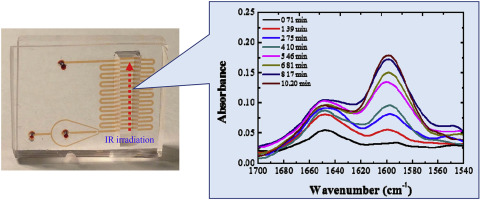当前位置:
X-MOL 学术
›
Anal. Chim. Acta
›
论文详情
Our official English website, www.x-mol.net, welcomes your
feedback! (Note: you will need to create a separate account there.)
IR-Compatible PDMS microfluidic devices for monitoring of enzyme kinetics
Analytica Chimica Acta ( IF 5.7 ) Pub Date : 2018-08-01 , DOI: 10.1016/j.aca.2018.03.006 Monpichar Srisa-Art , Scott D. Noblitt , Amber T. Krummel , Charles S. Henry
Analytica Chimica Acta ( IF 5.7 ) Pub Date : 2018-08-01 , DOI: 10.1016/j.aca.2018.03.006 Monpichar Srisa-Art , Scott D. Noblitt , Amber T. Krummel , Charles S. Henry

|
Coupling infrared (IR) spectroscopy to microfluidic devices provides a powerful tool for characterizing complex chemical and biochemical reactions. Examples of microfluidic devices coupled with infrared spectroscopy have been limited, however, largely due to the difficulties associated with fabricating systems in common infrared transparent materials like CaF2. Recent reports have shown that polydimethylsiloxane (PDMS) can be used as an IR transparent substrate when fabricated with thin layers. The use of soft lithography with PDMS expands the library of possible designs that can be achieved for IR measurements in microfluidics. In initial reports with thin PDMS, the target analytes were small molecules; however, IR spectroscopy offers a powerful tool to study protein structure and reactions. Here, a PDMS microfluidic device compatible with IR spectroscopy was fabricated by means of spin-coating of PDMS pre-polymer to obtain thin PDMS microfluidic features. The device was comprised of only PDMS and IR absorption of PDMS was significantly minimized due to the thickness (∼40 μm) of the PDMS layer. The use of thin PDMS allowed for measuring the amide I and II vibrational bands of proteins that have been difficult to measure in other microfluidic devices. To demonstrate the power of the system, the microfluidic device was successfully used to measure the enzyme kinetics as one class of important biochemical reactions with broad use in a variety of fields from medicine to biotechnology. As a model, the reaction of glucose oxidase with glucose was tracked by following the formation of gluconic acid. Michaelis-Menten kinetics from the device were compared with bulk solution measurements and found to be in good agreement.
中文翻译:

用于监测酶动力学的红外兼容 PDMS 微流体装置
将红外 (IR) 光谱耦合到微流体设备为表征复杂的化学和生化反应提供了强大的工具。然而,与红外光谱相结合的微流体装置的例子受到限制,这主要是由于在常见的红外透明材料(如 CaF2)中制造系统存在困难。最近的报告表明,聚二甲基硅氧烷 (PDMS) 在制造薄层时可用作 IR 透明基板。软光刻与 PDMS 的使用扩展了可用于微流体中红外测量的可能设计库。在使用薄 PDMS 的初步报告中,目标分析物是小分子;然而,红外光谱为研究蛋白质结构和反应提供了强大的工具。这里,通过旋涂 PDMS 预聚物来制造与红外光谱兼容的 PDMS 微流体装置,以获得薄的 PDMS 微流体特征。该装置仅由 PDMS 组成,并且由于 PDMS 层的厚度(~40 μm),PDMS 的红外吸收显着最小化。使用薄的 PDMS 可以测量蛋白质的酰胺 I 和 II 振动带,这些振动带在其他微流体装置中难以测量。为了证明该系统的强大功能,微流体装置成功地用于测量酶动力学,作为一类重要的生化反应,广泛应用于从医学到生物技术的各个领域。作为模型,葡萄糖氧化酶与葡萄糖的反应通过跟踪葡萄糖酸的形成来追踪。
更新日期:2018-08-01
中文翻译:

用于监测酶动力学的红外兼容 PDMS 微流体装置
将红外 (IR) 光谱耦合到微流体设备为表征复杂的化学和生化反应提供了强大的工具。然而,与红外光谱相结合的微流体装置的例子受到限制,这主要是由于在常见的红外透明材料(如 CaF2)中制造系统存在困难。最近的报告表明,聚二甲基硅氧烷 (PDMS) 在制造薄层时可用作 IR 透明基板。软光刻与 PDMS 的使用扩展了可用于微流体中红外测量的可能设计库。在使用薄 PDMS 的初步报告中,目标分析物是小分子;然而,红外光谱为研究蛋白质结构和反应提供了强大的工具。这里,通过旋涂 PDMS 预聚物来制造与红外光谱兼容的 PDMS 微流体装置,以获得薄的 PDMS 微流体特征。该装置仅由 PDMS 组成,并且由于 PDMS 层的厚度(~40 μm),PDMS 的红外吸收显着最小化。使用薄的 PDMS 可以测量蛋白质的酰胺 I 和 II 振动带,这些振动带在其他微流体装置中难以测量。为了证明该系统的强大功能,微流体装置成功地用于测量酶动力学,作为一类重要的生化反应,广泛应用于从医学到生物技术的各个领域。作为模型,葡萄糖氧化酶与葡萄糖的反应通过跟踪葡萄糖酸的形成来追踪。











































 京公网安备 11010802027423号
京公网安备 11010802027423号